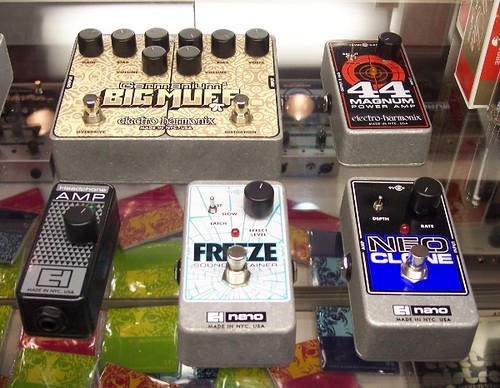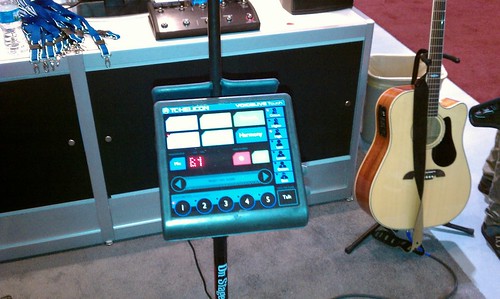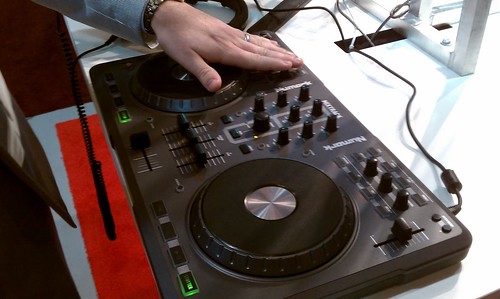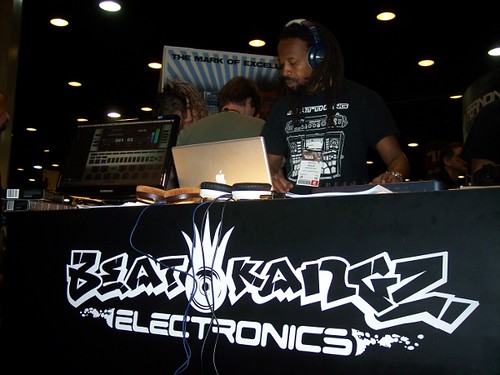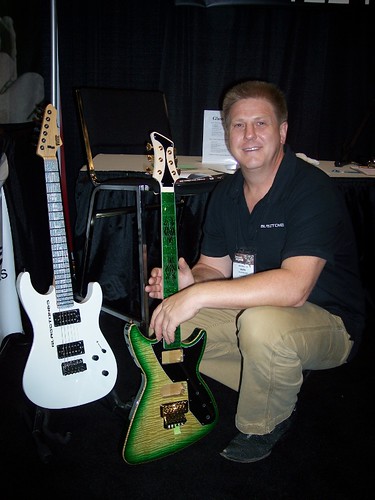Effect pedals on CDM? Heck, yes. Electro-Harmonix may have just stolen the show in Nashville with the Freeze pedal alone. Continuing our coverage with Nashville locals and musicians Tony and Jeremy, we have some hands-on videos, images, and impressions of the gear on offer. Don’t miss yesterday’s story on how the trade show helps Nashville recover from flooding. They offered a sobering picture of the state of the show, as well, but that didn’t stop them from finding good stuff to share. -Ed.
Summer NAMM was never the size of its winter counterpart. We were still surprised by the poor manufacturer turnout at the June 18th – 20th convention in Nashville, TN. Absent were heavy hitters like Roland and Korg and innovators like Moog, ZVex, and Dave Smith. Luckily, those that did attend brought some pretty cool new gear. Here are our impressions:
The VoiceLive Touch puts the famous TC-Helicon harmonization technology and effects in a unique, stand-mountable package, with the addition of performance-oriented looping. The unit feels very rugged, locking onto the stand to give the performer all of the controls at the right height. The interface is a simple array of touch “buttons” for access to the different DSP units with display duties being handled by a simple LED matrix display. Parameters are accessed and manipulated by a touch slider below the display. The VoiceLive Touch seems designed for quick access to presets in the middle of a gig rather than for delicate parameter tweaking. For ease of use during a set, the vocal harmonizer/looper looks like a winner. TC-Helicon says that while preset management over USB is the name of the game for the time being, a software editor could be in the cards down the road. In the first video, TC-Helicon rep Laura Davidson gives CDM a hands on look at the device. In the second video, a singer-songwriter demonstrates one of the harmonization presets. – JD
Previously on CDM: a preview of the device
Numark Mixtrack DJ USB Controller
The Mixtrack is a solid little device, preset for controlling Traktor for $150. For that price, this looks like an amazing little controller – touch sensitive platters for playback control matched with the full range of DJ-mixer style playback, pitch bend, EQ, and looping controls, many of which are illuminated. It’s class-compliant USB and operates as a simple MIDI controller, so it should work out of the box with any application with a fairly minimal amount of mapping and setup. The Mixtrack supports Mac and Windows with possible future Linux support, “if the customer demand is there.” Ed.: actually, since it’s class-compliant, it will already work on Linux. It’s plastic, but it feels quite solid to lift. The encoders have a nice size and grip, with a just a touch of resistance when turning: you don’t feel like you’re going to pull the encoder off of the front panel when adjusting the EQ. I don’t think the crossfader is going to win any awards when put against a DJ battle-style mixer, but it seems like it will do the job without any complaints, especially considering the price of the unit. While the unit is obviously very portable, it may be just a bit outsized for most laptop bags; but that goes with almost every portable controller out there that isn’t named “micro”. In the video, Numark rep Eric McGregor gives CDM an in-depth look. -JD
The Multimix8 is another iteration of small mixer/USB interface device from Alesis – 8 channels, 4 with microphone preamps, a high-impedance instrument input on channel 2, and 2 pairs of stereo line inputs. Built-in preset effects with individual sends on each channel, all mixed to a class-compliant 2-channel 16/44.1 bidirectional USB audio interface. Alesis is apparently taking user feedback from their original MultiMix8 USB to improve panel layout and knob spacing, dropping 24/96 support and reducing the power consumption. We were quoted $149 street price, which is only around $10 or so off the predecessor’s street price. -JD
A personal highlight for me was finally getting the chance to meet Aja and the Nashville-based Beat Kangz crew. I was impressed with their end-user friendly approach to the marketplace, valuing user feedback on their products. News to me is that Beat Thang Virtual is getting an AudioUnit version within the next two weeks, with VST coming soon after. I think that getting that product integrated with existing DAWs is going to do a lot for them. Of course, the one everyone is waiting for is the Beat Thang Beat Machine. It was there in all of its prototype glory, although Aja said that the first shipment of test units at full production spec were going to be in their hands soon, with some small tweaks to the hardware (particularly with the feel of the pads) ready to go through a final beta test phase. If their goal is to make the ultimate beat production device, I think they stand a really good chance of delivering. The prototype box is solid as a rock, intuitive interface and spec’d out to be an MPC killer. At $1000, it’s hard not to be interested in this box if you do any kind of rhythmic production. In the first video Aja shows Create Digital Music the Beat Thang Virtual. In video two, Aja shows us the Beat Thang Beat Machine. – JD
What may be the first of its kind, Akai has released a hardware accessory for their SynthStation iPhone software. Unveiled at Winter NAMM, the controller is simplicity itself – It’s an iPhone dock with 25-key keyboard, mod and pitch bend wheels, Octave and Program buttons and 4 buttons for accessing the voices in the SynthStation application itself. Couple this with headphone and RCA outputs and USB interface for MIDI, and Akai is offering a package to give actual musical performance control to their iPhone app. The relative merits of the controller or even the use of iPhones for performance and composition aside, Akai is making a strong move here by being the first to market with such a device. Given the sales of SynthStation in the iTunes store, Akai is betting that there are a significant number of people out there that would want to have an extended musical experience with their app and that those people are going to pony up around $100-$150 for a dedicated hardware controller for it. The release date has slipped on this device at least once already, but they seem to be pushing for July at this point. Interestingly, Akai is going to make their API available to third party developers, wishing to allow opening up the SynthStation25 to other iPhone applications. – JD
Shipping in late June, The Electro-Harmonix Freeze sample-and-hold pedal may be my favorite effect unit at Summer NAMM. The concept is deceptively simple: press down on the footswitch and the unit sustains what you just played. Let go and the sustaining stops. In the meantime, you can layer over the frozen part with additional notes. See the video below for a great demonstration. The Freeze seems perfect for experimental music and non-guitar instruments. Homebrew modifications are inevitable.
EH showed off other new products, including the Germanium 4 Big Muff Pi distortion/overdrive (so named because of its 4 germanium transistors), the Neo Clone (smaller version of the Small Clone analog chorus), and tiny Headphone Amp. In the video below, Larry with EH gave CDM a demonstration of these effects as well as the Ring-Thing Ring Modulator. Ed.: Or, as they describe it, to be semantic, a “single sideband modulator.” The unique thing about the Ring-Thing is that you can tune it from an incoming signal and avoid the unwieldy dissonance that come from most ring mods. Of course, unwieldy dissonance is a ring mod’s main charm. But should you want it to sound more musical, you have that option. – TY
Guitar-pedal bad-boys Pigtronix debuted an innovate universal signal router at Summer NAMM called the Keymaster Re-Amp Effects Mixer. Unlike most loopers, the Keymaster has a plethora of input/output options, including xlr and 1/4” in/outs and two pedal-level effects loops. You can run the loops in series or parallel with the option to mix the two loops in parallel mode. The beauty of this pedal is the limitless ways you can use it. Power two amps at once, instantly switch between two amps on the fly, switch between two effects chains, blend two effects chains, put two instruments in the two return jacks and mix them together to a single amp, and any routing you can dream up.
In the video below, Pigtronix founder Dave Koltai gives CDM an in-depth tour of the Keymaster. The second video shows Dave Koltai sampling a variety of Pigtronix’s other innovated pedals, including the Mothership Analog Synthesizer, Philosopher King polyphonic amplitude synthesizer, EP2 Envelop Phaser, and the Echolocution. Great sounds! – TY
Mark Payung’s fledgling Glasstones guitar company isn’t a household name. . . yet. But that may change if the final Glasstones guitars sound as good at the prototype did at Summer NAMM. The secret of the guitar’s long sustain is a patented glass compound that the nut, frets, and fretboard are made of. Supposedly, the highly-dense material better transmits the vibrations of the strings into the wood. Mark excitedly took us over to his friends’ 3rd Power Amplification booth to let us hear the Glasstones prototype guitar through an American Dream amplifier. The American Dream amp features some innovations of its own, including a triangular speaker chamber and switchable output between 22 and 10 watts. Channel one is voiced to sound like a ‘62 brownface Deluxe; channel two, a ‘65 blackface Deluxe.
Of course, it’s always hard to tell what guitars and amps truly sound like unless you’re playing them with your own gear; but this combination under the ideal conditions of the show floor sounded fantastic. (Watch the video below to hear for yourself.) Time will tell if the Glasstones guitar is a game-changing innovation or a fly-by-night novelty. If I were forced to choose, I’d bet on the former. – TY
Tony Youngblood (story, photos) resides in Nashville, TN and hosts the experimental improv music podcast Theatre Intangible. [@tonyyoungblood, Twitter]
Jeremy Dickens (additional reporting, photos) is a native Nashvillian musician, engineer, sound designer and and producer with works on dPulse Recordings, Sony Digital and his own Discrepancy Recordings imprint. [@logickal, Twitter]
Want follow-up coverage of any of this gear? What strikes your fancy? Let us know in comments.
